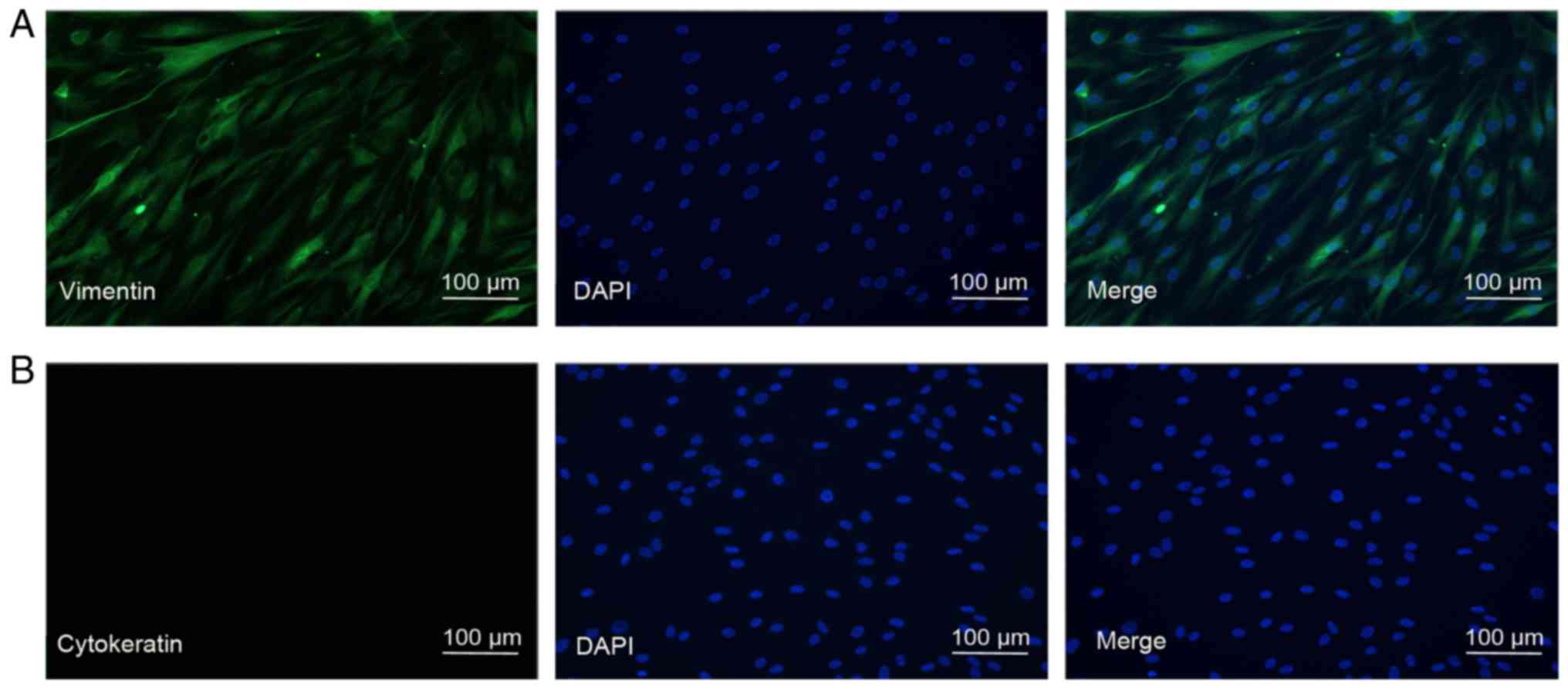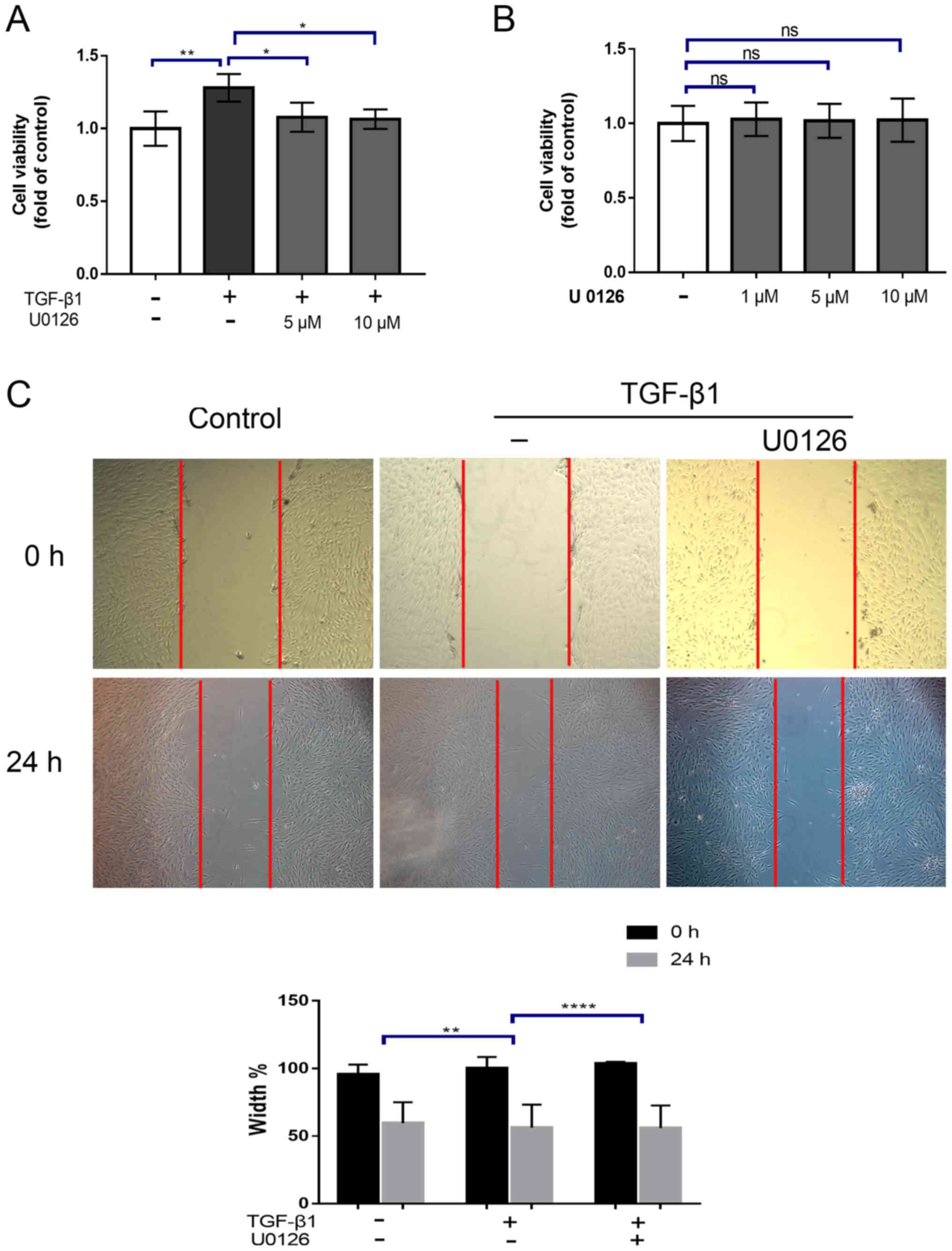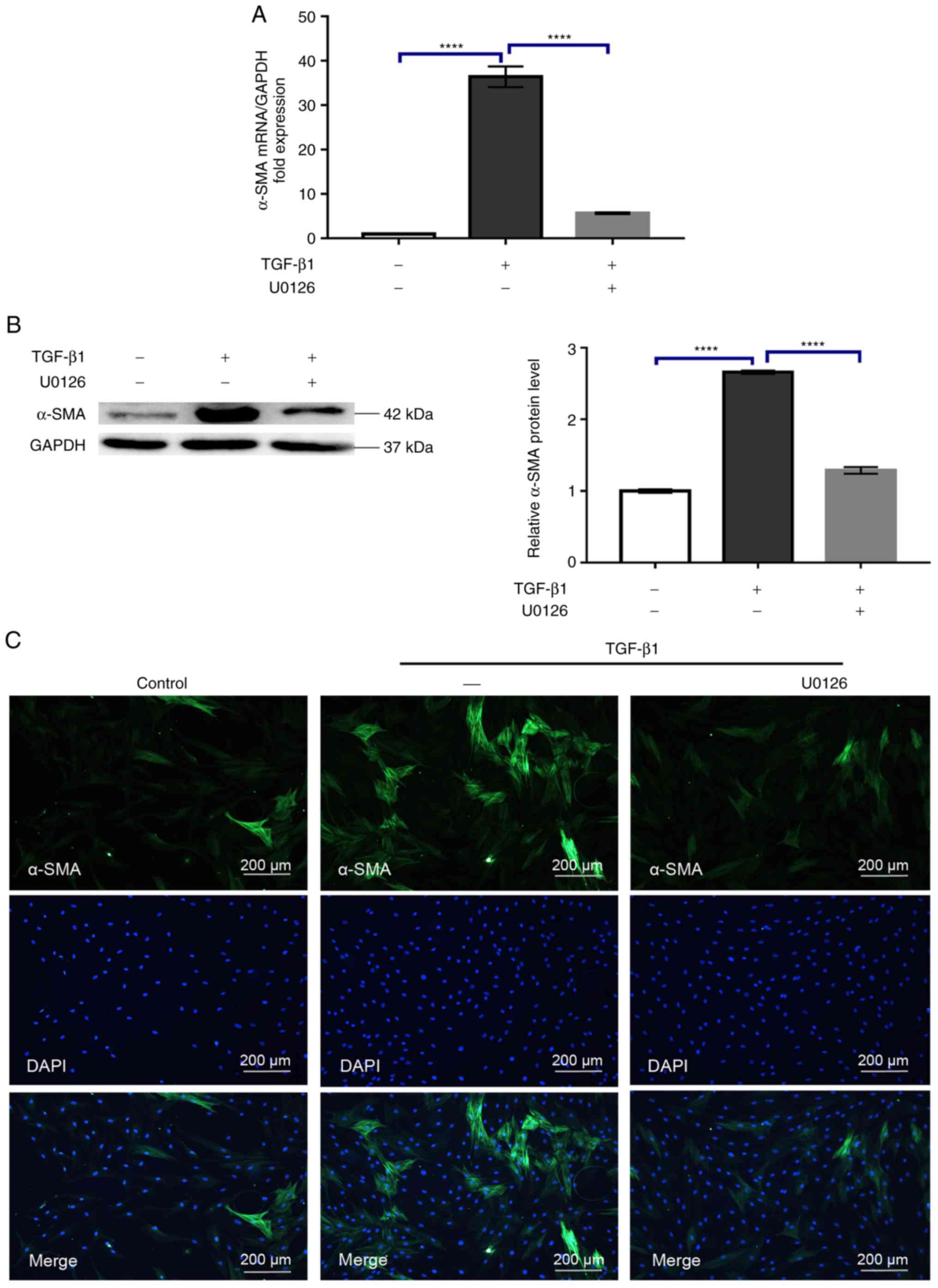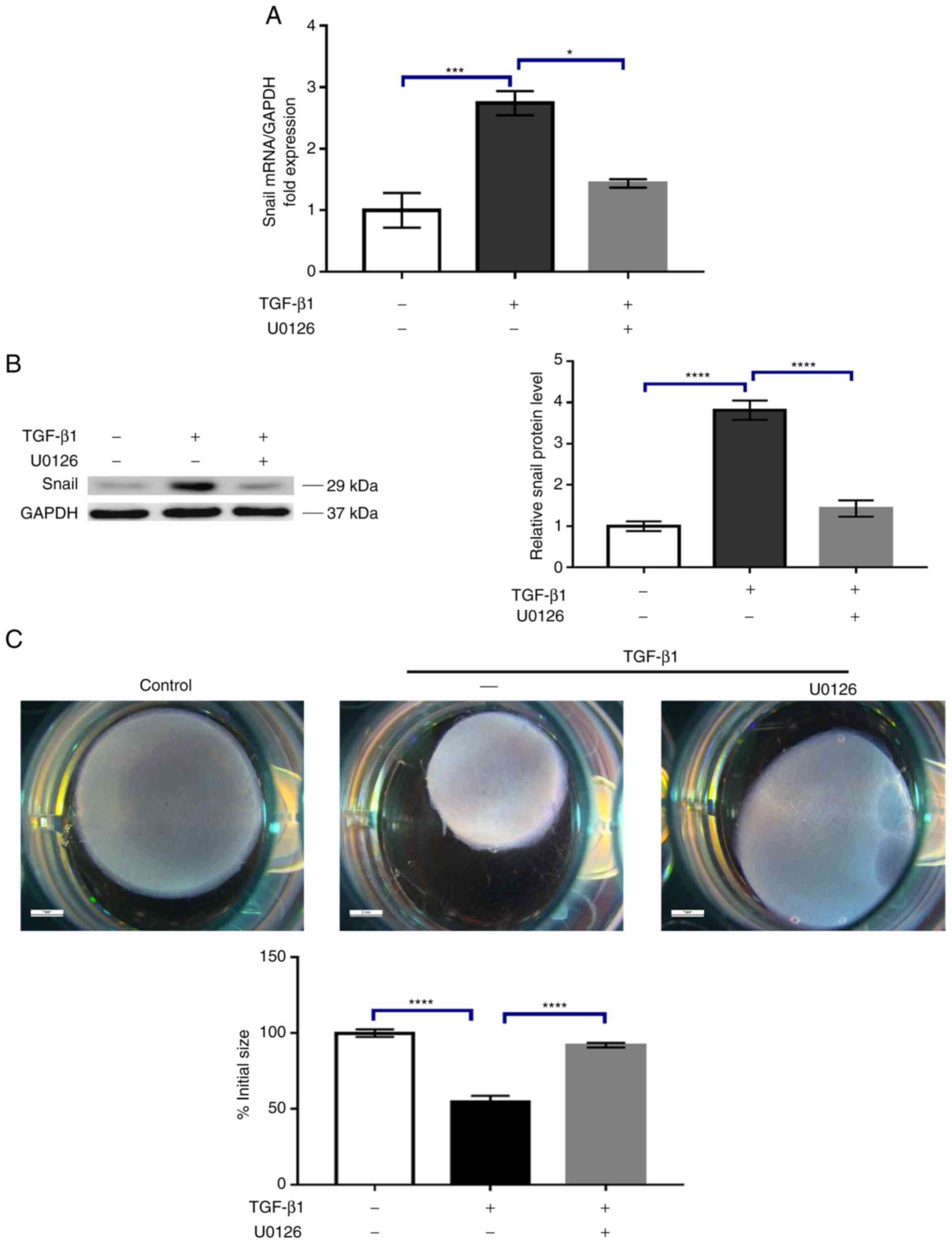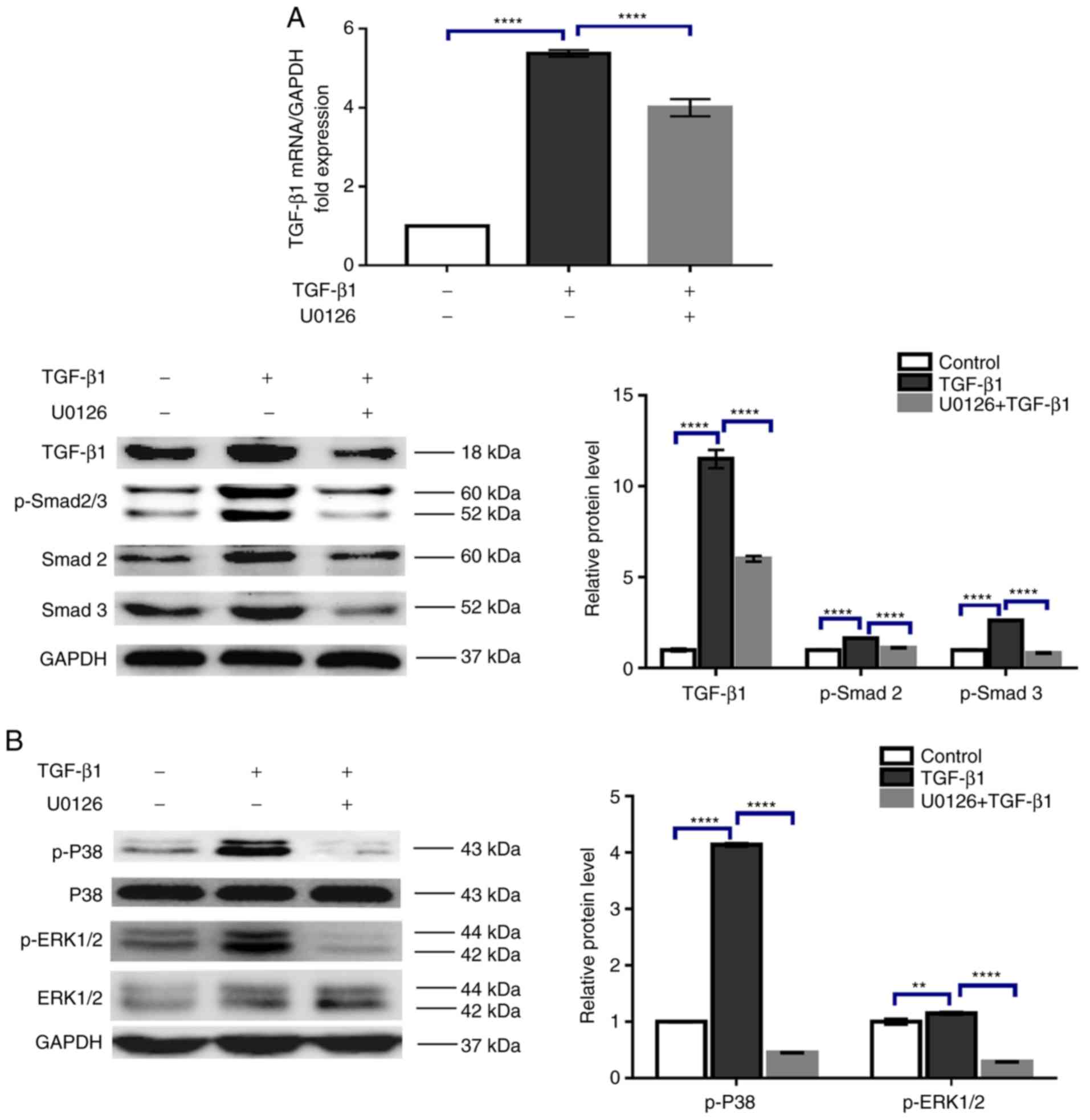MEK inhibition prevents TGF‑β1‑induced myofibroblast transdifferentiation in human tenon fibroblasts
- Authors:
- Published online on: November 20, 2018 https://doi.org/10.3892/mmr.2018.9673
- Pages: 468-476
-
Copyright: © Wen et al. This is an open access article distributed under the terms of Creative Commons Attribution License.
Abstract
Introduction
Trabeculectomy is considered the primary treatment method for patients with glaucoma (1) but its efficacy is limited by the frequency of postoperative subconjunctival fibrosis. Although anti-fibrotic drugs including mitomycin C (MMC) and 5-fluorouracil (5-FU) are commonly used (2), the surgical failure rate remains high and may lead to sight-threatening infections (3). There is an urgent requirement to elucidate the molecular mechanisms that drive the formation of fibrosis, and to explore alternative intervention strategies.
Activated human tenon fibroblasts (HTFs), characterized by myofibroblast transdifferentiation, are the central effector cells during fibrosis (4). Myofibroblasts drive fibrosis formation by increasing the production of extracellular matrix proteins including type I, III, V and type VI collagens (5). In addition, myofibroblasts secrete tissue inhibitors of metalloproteinases (TIMPs), decreasing the activity of extracellular matrix-degrading enzymes (6). Multiple stimuli have been identified to trigger fibroblasts activation, particularly growth factors and cytokine family members (7), of which the transforming growth factor-β (TGF-β) family are the most potent and well-documented mediators (8).
The human TGF-β family comprises 3 isoforms, designated TGF-β1, TGF-β2, and TGF-β3 (9). Despite previous data suggesting that all 3 TGF-β isoforms are identifiable in HTFs (10), TGF-β1 is the predominant isoform associated with subconjunctival scarring (11,12). Typically, TGF-β1 functions by binding to its heterodimeric receptor complex and causing phosphorylation of the downstream signal transduction proteins mothers against decapentaplegic homolog (Smad) 2 and Smad3, which in turn form complexes with Smad4, translocate to the nucleus and regulate target gene transcription (13). In addition to the canonical Smad pathway, members of the mitogen-activated protein kinase (MAPK) signaling pathways, including p38MAPK, extracellular signal-regulated kinase (ERK)1/2 and c-Jun-N-terminal kinase (JNK), are activated by TGF-β (14). Although the role of canonical Smad signaling in fibrosis has been well established, whether non-canonical MAPK signaling is involved in this process remains unverified.
The present study aimed to investigate the role of the MEK1/2 inhibitor U0126 on HTF activation, including proliferation, migration, and α-smooth muscle actin (α-SMA) expression, and collagen contraction induced by TGF-β1. In addition, the present study also aimed to elucidate the underlying mechanisms of action by examining the activation statuses of the Smad2/3, ERK1/2 and p38MAPK signaling pathways.
Materials and methods
Cell culture
Samples of human Tenon's capsule were obtained from patients from the Zhongshan Ophthalmic Center (Sun Yat-sen University, Guangzhou, China), with the approval of the Ethical Committee of the Zhongshan Ophthalmic Center and in accordance with the Declaration of Helsinki. Informed consent was gained. Fresh tissues were cut into 1–2 mm pieces under a stereo microscope (×1.5), then placed in culture dishes with Dulbecco's modified Eagle's medium (DMEM)/F12 supplemented with 10% fetal bovine serum (both from Invitrogen; Thermo Fisher Scientific, Inc., Waltham, MA, USA), 100 U/ml penicillin and 100 µg/ml streptomycin at 37°C and 5% CO2. After 8 days, primary cultures (~60% confluence) were passaged with 0.25% trypsin-EDTA (Invitrogen; Thermo Fisher Scientific, Inc.). Cells at passages 3–6 were used in subsequent experiments. Cell identification was performed by immunostaining with the fibroblast marker vimentin and cytokeratin (Abcam, Cambridge, UK). Briefly, the cells were seeded on coverslip with 80–90%, and were fixed with 4% paraformaldehyde at room temperature for 30 min. After washing with PBS, the cells were permeated with 0.1% TritonX-100 for 15 min at room temperature. After blocking with 5% BSA for 30 min at room temperature, cells were incubated with antibody against vimentin (cat. no. 5741; Cell Signaling Technology, Inc., Danvers, MA, USA; 1:200) at 4°C overnight. Cells were then incubated with the secondary antibody Alexa Fluor 488 of goat anti-rabbit IgG antibody (cat. no. ab150077; Abcam; 1:500) at room temperature for 1 h, The nuclei were stained with DAPI (5 mg/ml) at room temperature for 1 min. Immunofluorescence was visualized using a fluorescence microscope (LSM710; Zeiss AG, Oberkochen, Germany) at 512×512 pixel resolution. Images were collected using a ×20 apochromatic objective.
Cell proliferation assay
HTFs proliferation was determined by Cell Counting kit-8 (CCK-8; Dojindo Molecular Technologies, Inc., Kumamoto, Japan) assay. Briefly, a 96-well plate was seeded with HTFs (1×104 cells/well) and incubated overnight at 37°C and 5% CO2. Following treatment with TGF-β1 (5 ng/ml) alone or in the presence of 5 or 10 µM of U0126, 10 µl CCK-8 solution was added to each well and incubated at 37°C for 4 h. A microplate reader was used to measure the absorbance at 450 nm (Bio-Rad Laboratories, Inc., Hercules, CA, USA).
Wound healing assay
HTFs (5×105) were seeded into 6-well plates and incubated to 100% confluence. The cell monolayer was scratched with a 200-µl pipette tip and washed with PBS, following which fresh DMEM/F12 containing TGF-β1 (5 ng/ml) alone or combined with 5 µM of U0126 was added and the plates incubated for 24 h. The distance of cell migration was measured via phase-contrast microscopy (magnification, ×20).
Fibroblast-mediated collagen contraction assay
A collagen contraction assay was performed using a Cell Biolabs Collagen Contraction Assay kit (Cell Biolabs, Inc., San Diego, CA, USA), according to the manufacturer's protocol. Briefly, HTFs (5×105 cells/well) and 500 µl collagen preparation were added to a 24-well plate for polymerization. Following treatment with TGF-β1 (5 ng/ml) alone or combined with 5 µM of U0126 for 24 h, gels were detached from the wells and images were captured under a light stereo microscope (magnification, ×1.5). Analyses were performed using ImageJ software 2.1.4.7 (National Institutes of Health, Bethesda, MD, USA).
Western blot analysis
Extracts were prepared by lysing cells with radioimmunoprecipitation assay lysis buffer (Beyotime Institute of Biotechnology, Shanghai, China) on ice for 10 min. Protein concentrations were quantified with a Micro bicinchoninic acid Protein Assay kit (Thermo Fisher Scientific, Inc.), according to the manufacturer's protocol. Protein lysates (30 µg) were separated via SDS-PAGE with 10% of separation gel and 3% stacking gel and then transferred to a polyvinylidene fluoride membrane (Thermo Fisher Scientific, Inc.). Proteins of interest were detected using primary antibodies against human α-SMA (cat. no. ab5694; 1:1,000) and GAPDH (cat. no. ab9485; 1:1,000; both Abcam), TGF-β1 (cat. no. sc-130348; 1:1,000; Santa Cruz Biotechnology, Inc., Dallas, TX, USA) Smad2 (cat. no. 5339; 1:1,000), Smad3 (cat. no. 9523; 1:1,000), phosphorylated (p)-Smad2/3 (cat. no. 8828; 1:1,000), p38MAPK (cat. no. 8690; 1:1,000), p-p38MAPK (cat. no. 4511; 1:1,000), ERK1/2 (cat. no. 4695; 1:1,000), p-ERK1/2 (cat. no. 4370; 1:1,000; all Cell Signaling Technology, Inc.) and zinc finger protein SNAI1 (cat. no. 3879; Cell Signaling Technology, Inc.; 1:1000), followed by incubation with mouse peroxidase-conjugated secondary antibodies (cat. no. sc-2357; Santa Cruz Biotechnology, Inc.; 1:2,000) for 1 h at room temperature. Specific proteins were visualized by enhanced chemiluminescence (cat. no. WBKLS0500; Merck KGaA, Darmstadt, Germany).
Reverse transcription quantitative polymerase chain reaction (RT-qPCR)
Total RNA was extracted from cultured cells using RNeasy spin columns (Qiagen Ltd., Crawley, UK) according to the manufacturer's protocol. cDNA was synthesized by reverse transcriptase from total RNA with PrimeScript RT Master Mix (Takara Bio Inc., Otsu, Japan). The RT reaction was conducted at 25°C, 5 min, followed by 55°C, 10 min, and the reaction was terminated by heating at 85°C for 5 min. qPCR was subsequently performed using the SYBR® Premix Ex Taq™ kit (RR820A; Takara Biotechnology Co., Ltd). The thermocycling conditions for qPCR is as follows: Initial denaturation at 95°C for 30 sec; 40 cycles of denaturing the cDNA template at 95°C for 10 sec and annealing/extension at 60°C for 30 sec. The gene expression levels were normalized to GAPDH according to the 2−∆∆Cq relative quantification method (15). The primers used in the experiment were as follows: GAPDH forward, 5′-GGAGCGAGATCCCTCCAAAAT-3′ and reverse, 5′-GGCTGTTGTCATACTTCTCATGG-3′; α-SMA forward, 5′-AAAAGACAGCTACGTGGGTG-3′ and reverse, 5′-GCCATGTTCTATCGGGTACTTC-3′; Snail forward, 5′-TCGGAAGCCTAACTACAGCGA-3′ and reverse, 5′-AGATGAGCATTGGCAGCGAG-3′; TGF-β1 forward, 5′-GGCCAGATCCTGTCCAAGC-3′ and reverse, 5′-GTGGGTTTCCACCATTAGCAC-3′.
Immunofluorescence staining
Cells were seeded onto coverslips once they reached 40–60% confluence. Upon treatment with the indicated agents, cells were fixed in 4% paraformaldehyde for 15 min at room temperature and then permeated with 0.1% Triton X-100 for 10 min. Following blocking with 3% bovine serum albumin (Sigma-Aldrich; Merck KGaA) for 1 h at room temperature, the cells were incubated with a primary antibody against α-SMA (cat. no. ab5694; Abcam; 1:200) or cytokeratin (cat. no. 5741; 1:200; Cell Signaling Technology, Inc.) at 4°C overnight, and then exposed to the Alexa Fluor® 488-conjugated green fluorescence secondary antibodies (cat. no. ab150077; 1:500) or Alexa Fluor® 555-conjugated of red fluorescence secondary antibodies (cat. no. ab150158; 1:500; both Abcam) for 1 h at room temperature. The nuclei were stained with DAPI (5 mg/ml) for 1 min at room temperature and images were captured using a Leica fluorescence microscope (magnification, ×20).
Statistical analysis
All experiments were performed at least three times and the data are presented as the means ± standard deviation. Comparisons among multiple groups were performed by one-way analysis of variance with Tukey's post-hoc test using GraphPad Prism version 7.0 (GraphPad Software, Inc., La Jolla, CA, USA). P<0.05 was considered to indicate a statistically significant difference.
Results
Morphology and molecular characterization of HTFs
First, the present study aimed to identify the primary cultured HTFs. The cells were grown in a monolayer and exhibited a typical spindly, generally flat and elongated shape (Fig. 1). To identify HTFs at a molecular level, immunostaining using vimentin and cytokeratin, cell surface markers for fibroblasts and the epithelium, respectively, was performed. As indicated in Fig. 1, the HTFs exhibited extensive staining for vimentin and not for cytokeratin, suggesting that the isolated HTFs were of high purity.
U0126 attenuates TGF-β1-induced HTF proliferation and migration
Activated fibroblasts generally exhibit a high degree of proliferation and migration. To ascertain whether the inhibition of MEK signaling may suppress the HTF proliferation induced by TGF-β1, HTFs were incubated with TGF-β1 (5 ng/ml) alone or in the presence of 5 or 10 µM of the MEK1/2 inhibitor U0126. Cell proliferation was determined using a CCK-8 assay. It was identified that treatment with TGF-β1 for 24 h significantly increased the proliferation of HTFs (P<0.01; Fig. 2A), which was abrogated by pre-treatment with U0126. (P<0.05; Fig. 2A). However, no significant difference in the effects between 5 and 10 µM treatments was observed. Notably, treatment with U0126 alone had no significant effect on cell viability (Fig. 2B). Next, the effect of U0126 on HTF migration was evaluated using a scratch wound assays. As indicated in Fig. 2, cell migration was significantly increased upon treatment with TGF-β1 for 24 h (relative wound width=44.2±4.5% TGF-β1 vs. 57.6±2.1% vehicle control; P<0.001; Fig. 2C). This effect was also substantially attenuated by pre-treatment with 5 µM U0126 (relative wound width =73.6±6.1% TGF-1β+U0126 vs. 41.1±4.8% TGF-1β; P<0.01; Fig. 2C). Collectively, these results indicated that U0126 may markedly inhibit HTF proliferation and migration simulated by TGF-β1.
U0126 prevents the conversion of HTFs into myofibroblasts by TGF-β1
The transdifferentiation of fibroblasts into myofibroblasts is considered a pivotal step during fibrosis. At the molecular level, this process is characterized by the upregulation of α-SMA expression (16). To determine the effect of U0126 on the TGF-β1-induced conversion of fibroblasts into myofibroblasts, the changes in α-SMA mRNA and protein expression were evaluated via RT-qPCR and western blot analysis, respectively. As indicated in Fig. 3A and B, while TGF-β1 exposure increased α-SMA mRNA and protein expression, as expected, this effect was compromised by 5 µM U0126 (P<0.0001). Additional immunofluorescence was performed to monitor the expression of α-SMA following treatment with 5 µM U0126, anda similar result was obtained (Fig. 3C). In addition to α-SMA, previous studies have indicated that Snail, a transcription factor that serves a critical role in epithelial-mesenchymal transition (EMT), is also involved in the switching of fibroblasts into myofibroblasts. Therefore, the effect of U0126 on the expression of Snail induced by TGF-β1 was examined. The results demonstrated that, while untreated HTF cells exhibited low levels of Snail expression, incubation with 5 ng/ml TGF-β1 resulted in a marked increase in Snail expression (Fig. 4A and B). Similarly, 5 µM U0126 largely attenuated TGF-β1-induced Snail mRNA and protein expression (Fig. 4A and B). At the functional level, activated HTFs contribute to contraction of the extracellular matrix, a hallmark of scar formation (17). Therefore, whether U0126 may inhibit the collagen matrix contraction response induced by TGF-β1 was determined. As expected, TGF-β1 treatment lead to enhanced collagen matrix contraction compared with the vehicle control (P<0.0001; Fig. 4C). Treatment with 5 µM U0126 significantly decreased the collagen matrix contraction induced by TGF-β1 (P<0.0001; Fig. 4C). Altogether, these results support the hypothesis that U0126 may potently prevent HTF transdifferentiation into myofibroblasts.
U0126 suppressed the TGF-β1-stimulated phosphorylation of Smad2/3, P38MAPK, and ERK1/2 in HTFs
TGF-β1 has been demonstrated to mediate the canonical Smad2/3 and the non-canonical MAPK pathways in various cell types. To reveal the mechanism underlying U0126-inhibition of HTF activation, the activation status of these signaling pathways in HTFs was evaluated. Smad2/3 and P38MAPK phosphorylation levels were detected by western blot analysis, and the results suggested that treatment with 5 ng/ml TGF-β1 induced activation of the Smad2/3 signaling pathway, as reflected by the increased levels of TGF-β1 mRNA and protein expression and Smad2/3 phosphorylation, which was in agreement with previous studies (18,19) (Fig. 5A). Furthermore, the phosphorylation of non-canonical p38MAPK and ERK1/2 proteins was also stimulated by TGF-β1 (Fig. 5B). Exposure to 5 µM U0126 markedly impaired TGF-β1-induced TGF-β1 mRNA and protein expression, and the phosphorylation of Smad2/3, p38MAPK and ERK1/2 (Fig. 5A and B). Therefore, the data suggested that U0126 prevents HTF activation through suppression of the Smad2/3, p38MAPK and ERK1/2 signaling pathways.
Discussion
In the present study, it was observed that U0126, a specific MEK1/2 inhibitor, has a potent antifibrotic effect among cultured HTFs stimulated by TGF-β1. Functionally, U0126 prevented TGF-β1-induced HTF proliferation, migration and 3D collagen contraction responses. U0126 may inhibit HTF conversion into myofibroblasts by downregulating α-SMA and Snail expression. The phosphorylation of Smad2/3, ERK1/2 and P38MAPK was significantly attenuated by U0126 treatment, suggesting that U0126 inhibits HTF activation via suppressing the classical and non-classical signaling pathways of TGF-β1.
The activation of fibroblasts is a typical characteristic of fibrotic injury, not only in the ocular region but in the whole body (20). Therefore, targeting the inhibition of fibroblast activation has been regarded as a critical intervention strategy for fibrotic diseases. In ocular tissue, although certain anti-mitotic agents including MMC and 5-FU have been employed to contract trabeculectomy-associated subconjunctival fibroblasts (21,22), they often result in serious postoperative complications, including bleb leakage, hypotony maculopathy and endophthalmitis (23,24). The data indicating that U0126 potently prevents HTF activation indicates an alternative targeting approach for this disease. It should be noted that a concentration-dependent inhibitory effect of U0126 on HTF activation, at least for cell proliferation, was not observed. Previous studies in other cell types suggested that U0126 prevented TGF-β-induced cell proliferation in a dose-dependent manner, but not α-SMA and Collagen 1 expression (25,26). Therefore, it was hypothesized that the concentration-dependent effect of U0126 may depend on the specific cellular events evaluated.
As with any drug, the potential side effects of U0126 should be considered when assessing its effect on the Ras/rapidly accelerated fibrosarcoma (Raf)/MEK/ERK signaling pathway. In particular, the possible effect of U0126 on retinal ganglion cell (RGC) survival, which is closely associated with glaucoma pathogenesis (27). However, given that the role of Raf/MEK/ERK signaling pathway inhibition in RGC survival remains controversial, with several studies indicating a pro-apoptosis effect and others a protective action (28–30), whether the use of U0126 may have an adverse or beneficial effect on RGC survival requires additional investigation.
The transdifferentiation of fibroblasts into myofibroblasts is a hallmark of fibroblast activation. At the molecular level, myofibroblasts are characterized by increased α-SMA expression (31), the actin isoform typically expressed in smooth muscle cells. Furthermore, the Snail transcription factor usually involved in EMT has been demonstrated to participate in myofibroblast transdifferentiation (32). In the present study, it was identified that TGF-β1 augmented the expression of α-SMA and Snail at both the mRNA and protein levels in HTFs. These effects were primarily inhibited by pre-treatment with U0126. Furthermore, the inhibitory effect of U0126 at the functional level was verified by performing 3D collagen lattice contraction experiments, which mimic the situation in vivo during wound healing, and obtained a consistent result. The results of the present study are in agreement with several other studies indicating that U0126 inhibits fibroblast transdifferentiation in other tissues (33,34), suggesting that U0126 may serve as an anti-fibrotic agent in general.
TGF-β1 acts by binding to two serine/threonine receptors, namely TGF-β type I and type II receptors, in target cells, which results in the activation of multiple signaling cascade pathways, including the canonical Smad2/3 pathway and non-canonical MAPK signaling pathways including p38MAPK, ERK1/2 and JNK (35,36). In general, activated Smad2/3 form complexes with Smad4, subsequently translocating to the nucleus and regulating the expression of genes associated with fibroblast proliferation, migration and extracellular matrix deposition (37). In addition to the canonical pathway, there is increasing evidence to support that the non-canonical pathway also has a vital role in mediating TGF-β1-induced cellular functions in the fibroblasts of numerous tissue types (38,39). As for HTFs, it has been suggested that the inhibition of p38MAPK is sufficient to prevent the conversion of HTFs into myofibroblasts (14). In the present study, it was demonstrated that treatment with U0126 significantly impeded TGF-β1-induced Smad2/3, p38MAPK and ERK1/2 activation. The data suggested that the canonical Smad2/3 and non-canonical p38MAPK and ERK1/2 signaling pathways are critical for maintaining the activated phenotype of HTFs, and that the inhibition of one of these pathways is sufficient to restore the phenotype activated by TGF-β1. We speculate that this phenomenon may be explained by potential crosstalk between Smad2/3, p38MAPK and ERK1/2 pathways in HTFs. For example, data obtained with other cell types indicate that p38MAPK may phosphorylate and increase the transcription of Smad2/3 (40,41). Furthermore, ERK1/2 has been revealed to regulate Smad2/3 activity in chondrocytes and hepatoma cells (42,43). Therefore, ERK1/2 may function as an upstream signal kinase of Smad2/3 in HTFs.
In summary, the present study provided evidence that the inhibition of the MEK signaling pathway has an effect on TGF-β1-induced HTF activation. This result provides an experimental basis for the clinical application of MEK inhibitors in the treatment of trabeculectomy-associated fibrotic disease.
Acknowledgements
Not applicable.
Funding
This work is funded by Guangdong Natural Science Foundation (grant no. 2015A030313171), National Natural Science Foundation of China (grant no. 81200685), Guangdong Province Science & Technology Plan (grant no. 2014B020228002) and Program for Outstanding Young Teacher of Sun Yat-sen University (grant no. 17ykpy76). The funders had no role in study design, data collection, and analysis, decision to publish, or preparation of the manuscript.
Availability of data and materials
All data generated or analyzed during this study are included in this published article.
Authors' contributions
JW and XL conceived and performed the experiments. JW performed the statistical analysis. XL and MY wrote the manuscript with input from WG, BQ, YL and RL. All authors approved the final version of the manuscript for publication.
Ethics approval and consent to participate
The present study was approved by the Ethical Committee of the Zhongshan Ophthalmic Center and performed in accordance with the Declaration of Helsinki. Informed consent was obtained.
Patient consent for publication
Written informed consent was obtained.
Competing interests
The authors declare that they have no competing interests.
References
|
Fan Gaskin JC, Nguyen DQ, Soon Ang G, O'Connor J and Crowston JG: Wound healing modulation in glaucoma filtration surgery-conventional practices and new perspectives: The role of antifibrotic agents (Part I). J Curr Glaucoma Pract. 8:37–45. 2014. View Article : Google Scholar : PubMed/NCBI | |
|
Pimentel E and Schmidt J: Is mytomicyn better than 5-fluorouracil as antimetabolite in trabeculectomy for glaucoma? Medwave. 18:e71372018.(In English, Spanish). View Article : Google Scholar : PubMed/NCBI | |
|
Kitazawa Y, Kawase K, Matsushita H and Minobe M: Trabeculectomy with mitomycin. A comparative study with fluorouracil. Arch Ophthalmol. 109:1693–1698. 1991. View Article : Google Scholar : PubMed/NCBI | |
|
Shi H, Wang H, Fu S, Xu K, Zhang X, Xiao Y and Ye W: Losartan attenuates scar formation in filtering bleb after trabeculectomy. Invest Ophthalmol Vis Sci. 58:1478–1486. 2017. View Article : Google Scholar : PubMed/NCBI | |
|
Chang L, Crowston JG, Cordeiro MF, Akbar AN and Khaw PT: The role of the immune system in conjunctival wound healing after glaucoma surgery. Surv Ophthalmol. 45:49–68. 2000. View Article : Google Scholar : PubMed/NCBI | |
|
Hinz B, Phan SH, Thannickal VJ, Prunotto M, Desmoulière A, Varga J, De Wever O, Mareel M and Gabbiani G: Recent developments in myofibroblast biology: Paradigms for connective tissue remodeling. Am J Pathol. 180:1340–1355. 2012. View Article : Google Scholar : PubMed/NCBI | |
|
Hartupee J and Mann DL: Role of inflammatory cells in fibroblast activation. J Mol Cell Cardiol. 93:143–148. 2016. View Article : Google Scholar : PubMed/NCBI | |
|
Carthy JM: TGFβ signaling and the control of myofibroblast differentiation: Implications for chronic inflammatory disorders. J Cell Physiol. 233:98–106. 2018. View Article : Google Scholar : PubMed/NCBI | |
|
Nickel J, Ten Dijke P and Mueller TD: TGF-β family co-receptor function and signaling. Acta Biochim Biophys Sin (Shanghai). 50:12–36. 2018. View Article : Google Scholar : PubMed/NCBI | |
|
Lin X, Yu M, Wu K, Yuan H and Zhong H: Effects of pirfenidone on proliferation, migration, and collagen contraction of human Tenon's fibroblasts in vitro. Invest Ophthalmol Vis Sci. 50:3763–3770. 2009. View Article : Google Scholar : PubMed/NCBI | |
|
Li DQ, Lee SB and Tseng SC: Differential expression and regulation of TGF-beta1, TGF-beta2, TGF-beta3, TGF-betaRI, TGF-betaRII and TGF-betaRIII in cultured human corneal, limbal, and conjunctival fibroblasts. Curr Eye Res. 19:154–161. 1999. View Article : Google Scholar : PubMed/NCBI | |
|
Fu S, Sun L, Zhang X, Shi H, Xu K, Xiao Y and Ye W: 5-Aza-2′-deoxycytidine induces human Tenon's capsule fibroblasts differentiation and fibrosis by up-regulating TGF-β type I receptor. Exp Eye Res. 165:47–58. 2017. View Article : Google Scholar : PubMed/NCBI | |
|
Stahnke T, Kowtharapu BS, Stachs O, Schmitz KP, Wurm J, Wree A, Guthoff RF and Hovakimyan M: Suppression of TGF-β pathway by pirfenidone decreases extracellular matrix deposition in ocular fibroblasts in vitro. PLoS One. 12:e01725922017. View Article : Google Scholar : PubMed/NCBI | |
|
Meyer-Ter-Vehn T, Gebhardt S, Sebald W, Buttmann M, Grehn F, Schlunck G and Knaus P: p38 inhibitors prevent TGF-beta-induced myofibroblast transdifferentiation in human tenon fibroblasts. Invest Ophthalmol Vis Sci. 47:1500–1509. 2006. View Article : Google Scholar : PubMed/NCBI | |
|
Livak KJ and Schmittgen TD: Analysis of relative gene expression data using real-time quantitative PCR and the 2(-Delta Delta C(T)) method. Methods. 25:402–408. 2001. View Article : Google Scholar : PubMed/NCBI | |
|
Shu DY and Lovicu FJ: Myofibroblast transdifferentiation: The dark force in ocular wound healing and fibrosis. Prog Retin Eye Res. 60:44–65. 2017. View Article : Google Scholar : PubMed/NCBI | |
|
Hsu CK, Lin HH, Harn HI, Hughes MW, Tang MJ and Yang CC: Mechanical forces in skin disorders. J Dermatol Sci. 90:232–240. 2018. View Article : Google Scholar : PubMed/NCBI | |
|
Liu Y, Kimura K, Orita T, Teranishi S, Suzuki K and Sonoda KH: Inhibition by all-trans-retinoic acid of transforming growth factor-β-induced collagen gel contraction mediated by human tenon fibroblasts. Invest Ophthalmol Vis Sci. 55:4199–4205. 2014. View Article : Google Scholar : PubMed/NCBI | |
|
Meyer-ter-Vehn T, Sieprath S, Katzenberger B, Gebhardt S, Grehn F and Schlunck G: Contractility as a prerequisite for TGF-beta-induced myofibroblast transdifferentiation in human tenon fibroblasts. Invest Ophthalmol Vis Sci. 47:4895–4904. 2006. View Article : Google Scholar : PubMed/NCBI | |
|
Wallace HA and Bhimji SS: Wound, Healing, Phases, in StatPearls. StatPearls Publishing StatPearls Publishing LLC; Treasure Island (FL): 2017 | |
|
Reiter C, Wimmer S, Schultheiss A, Klink T, Grehn F and Geerling G: Corneal epitheliopathy following trabeculectomy with postoperative adjunctive 5-fluorouracil. Klin Monbl Augenheilkd. 227:887–891. 2010.(In German). View Article : Google Scholar : PubMed/NCBI | |
|
Fan Gaskin JC, Nguyen DQ, Soon Ang G, O'Connor J and Crowston JG: Wound healing modulation in glaucoma filtration surgery-conventional practices and new perspectives: Antivascular endothelial growth factor and novel agents (Part II). J Curr Glaucoma Pract. 8:46–53. 2014. View Article : Google Scholar : PubMed/NCBI | |
|
Bindlish R, Condon GP, Schlosser JD, D'Antonio J, Lauer KB and Lehrer R: Efficacy and safety of mitomycin-C in primary trabeculectomy: Five-year follow-up. Ophthalmology. 109:1336–1342. 2002. View Article : Google Scholar : PubMed/NCBI | |
|
Khaw PT, Sherwood MB, Doyle JW, Smith MF, Grierson I, McGorray S and Schultz GS: Intraoperative and post operative treatment with 5-fluorouracil and mitomycin-c: Long term effects in vivo on subconjunctival and scleral fibroblasts. Int Ophthalmol. 16:381–385. 1992. View Article : Google Scholar : PubMed/NCBI | |
|
Chang HH, Chang MC, Wu IH, Huang GF, Huang WL, Wang YL, Lee SY, Yeh CY, Guo MK, Chan CP, et al: Role of ALK5/Smad2/3 and MEK1/ERK signaling in transforming growth factor beta 1-modulated growth, collagen turnover and differentiation of stem cells from apical papilla of human tooth. J Endod. 41:1272–1280. 2015. View Article : Google Scholar : PubMed/NCBI | |
|
Chen X, Ye S, Xiao W, Wang W, Luo L and Liu Y: ERK1/2 pathway mediates epithelial-mesenchymal transition by cross-interacting with TGFβ/Smad and Jagged/Notch signaling pathways in lens epithelial cells. Int J Mol Med. 33:1664–1670. 2014. View Article : Google Scholar : PubMed/NCBI | |
|
Nickells RW: The cell and molecular biology of glaucoma: mechanisms of retinal ganglion cell death. Invest Ophthalmol Vis Sci. 53:2476–2481. 2012. View Article : Google Scholar : PubMed/NCBI | |
|
Gupta VK, You Y, Li JC, Klistorner A and Graham SL: Protective effects of 7,8-dihydroxyflavone on retinal ganglion and RGC-5 cells against excitotoxic and oxidative stress. J Mol Neurosci. 49:96–104. 2013. View Article : Google Scholar : PubMed/NCBI | |
|
Wei J, Jiang H, Gao H and Wang G: Raf-1 kinase inhibitory protein (RKIP) promotes retinal ganglion cell survival and axonal regeneration following optic nerve crush. J Mol Neurosci. 57:243–248. 2015. View Article : Google Scholar : PubMed/NCBI | |
|
Luo JM, Cen LP, Zhang XM, Chiang SW, Huang Y, Lin D, Fan YM, van Rooijen N, Lam DS, Pang CP and Cui Q: PI3K/akt, JAK/STAT and MEK/ERK pathway inhibition protects retinal ganglion cells via different mechanisms after optic nerve injury. Eur J Neurosci. 26:28–42. 2007. View Article : Google Scholar | |
|
Hinz B, Mastrangelo D, Iselin CE, Chaponnier C and Gabbiani G: Mechanical tension controls granulation tissue contractile activity and myofibroblast differentiation. Am J Pathol. 159:1009–1020. 2001. View Article : Google Scholar : PubMed/NCBI | |
|
Biswas H and Longmore GD: Action of SNAIL1 in cardiac myofibroblasts is important for cardiac fibrosis following hypoxic injury. PLoS One. 11:e01626362016. View Article : Google Scholar : PubMed/NCBI | |
|
Reichard JF and Petersen DR: Involvement of phosphatidylinositol 3-kinase and extracellular-regulated kinase in hepatic stellate cell antioxidant response and myofibroblastic transdifferentiation. Arch Biochem Biophys. 446:111–118. 2006. View Article : Google Scholar : PubMed/NCBI | |
|
Makino T, Jinnin M, Muchemwa FC, Fukushima S, Kogushi-Nishi H, Moriya C, Igata T, Fujisawa A, Johno T and Ihn H: Basic fibroblast growth factor stimulates the proliferation of human dermal fibroblasts via the ERK1/2 and JNK pathways. Br J Dermatol. 162:717–723. 2010. View Article : Google Scholar : PubMed/NCBI | |
|
Derynck R and Zhang YE: Smad-dependent and Smad-independent pathways in TGF-beta family signalling. Nature. 425:577–584. 2003. View Article : Google Scholar : PubMed/NCBI | |
|
Guo X and Wang XF: Signaling cross-talk between TGF-beta/BMP and other pathways. Cell Res. 19:71–88. 2009. View Article : Google Scholar : PubMed/NCBI | |
|
Pardali E, Sanchez-Duffhues G, Gomez-Puerto MC and Ten Dijke P: TGF-β-induced endothelial-mesenchymal transition in fibrotic diseases. Int J Mol Sci. 18(pii): E21572017. View Article : Google Scholar : PubMed/NCBI | |
|
Zeglinski MR, Roche P, Hnatowich M, Jassal DS, Wigle JT, Czubryt MP and Dixon IM: TGFβ1 regulates Scleraxis expression in primary cardiac myofibroblasts by a Smad-independent mechanism. Am J Physiol Heart Circ Physiol. 310:H239–H249. 2016. View Article : Google Scholar : PubMed/NCBI | |
|
Che X, Wang Q, Xie Y, Xu W, Shao X, Mou S and Ni Z: Astragaloside IV suppresses transforming growth factor-β1 induced fibrosis of cultured mouse renal fibroblasts via inhibition of the MAPK and NF-κB signaling pathways. Biochem Biophys Res Commun. 464:1260–1266. 2015. View Article : Google Scholar : PubMed/NCBI | |
|
Kamaraju AK and Roberts AB: Role of Rho/ROCK and p38 MAP kinase pathways in transforming growth factor-beta-mediated Smad-dependent growth inhibition of human breast carcinoma cells in vivo. J Biol Chem. 280:1024–1036. 2005. View Article : Google Scholar : PubMed/NCBI | |
|
Iwayama H, Sakamoto T, Nawa A and Ueda N: Crosstalk between Smad and mitogen-activated protein kinases for the regulation of apoptosis in cyclosporine A- induced renal tubular injury. Nephron Extra. 1:178–189. 2011. View Article : Google Scholar : PubMed/NCBI | |
|
Zhu Y, Gu J, Zhu T, Jin C, Hu X and Wang X: Crosstalk between Smad2/3 and specific isoforms of ERK in TGF-β1-induced TIMP-3 expression in rat chondrocytes. J Cell Mol Med. 21:1781–1790. 2017. View Article : Google Scholar : PubMed/NCBI | |
|
Boye A, Kan H, Wu C, Jiang Y, Yang X, He S and Yang Y: MAPK inhibitors differently modulate TGF-β/Smad signaling in HepG2 cells. Tumour Biol. 36:3643–3651. 2015. View Article : Google Scholar : PubMed/NCBI |



